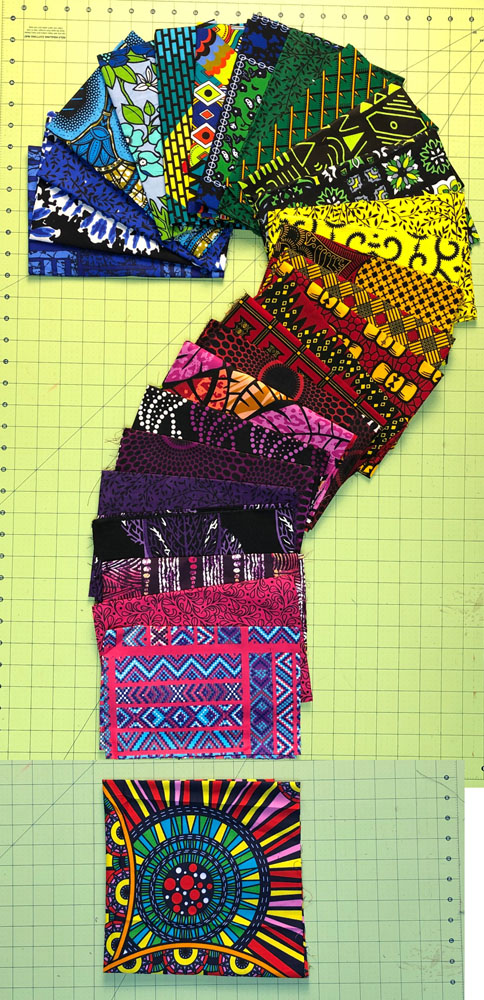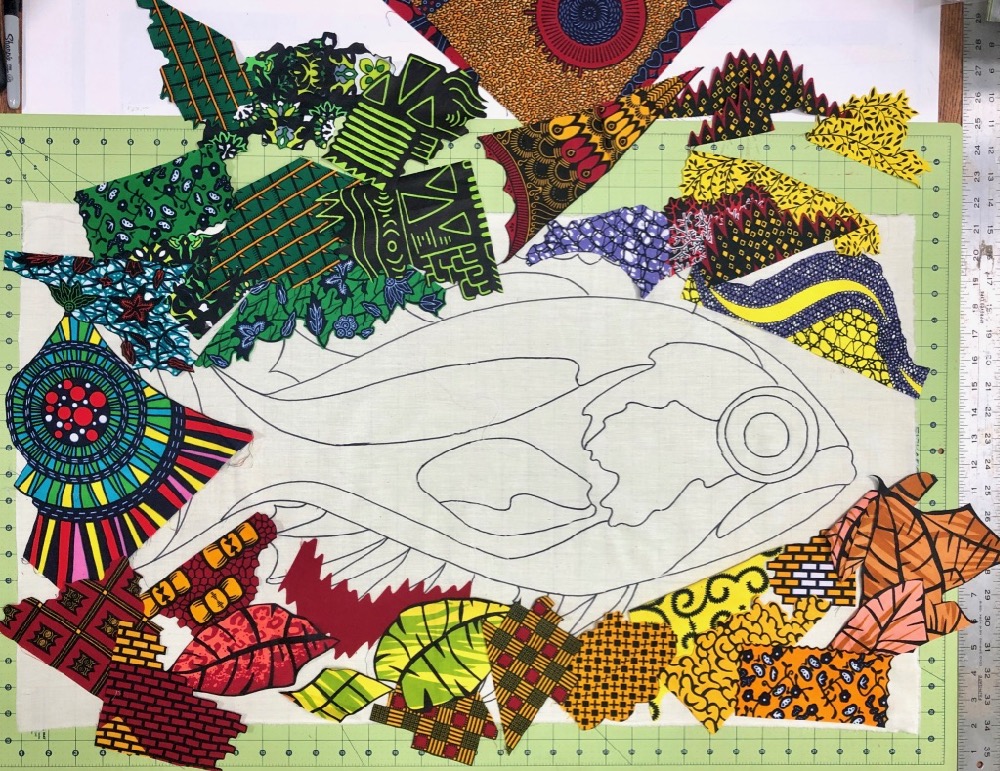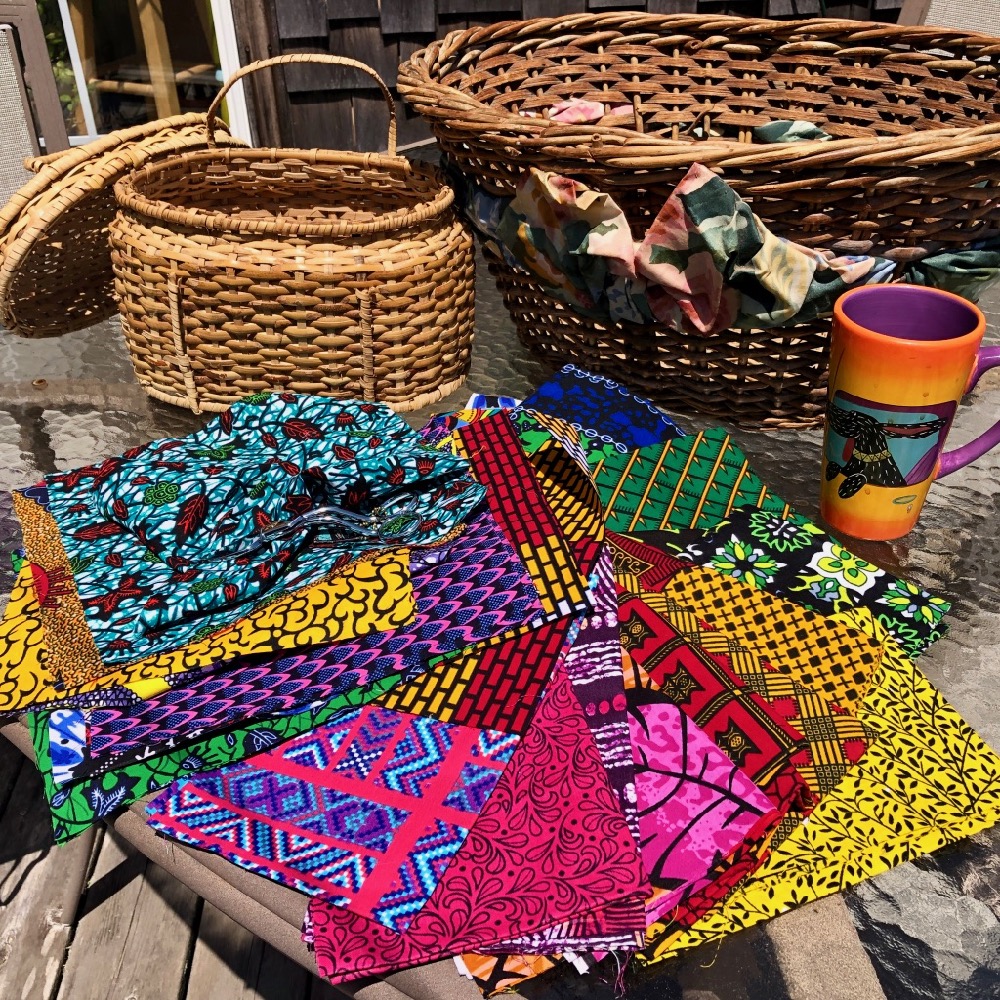
As promised in the Throwback Thursday post of two days ago, today I’ll be sharing a bit of the playtime I’ve been having with some African fabric.
And for me, playtime starts with creating a fabric palette with a few of my selected fabrics, as seen in the photo above. I even sat outside in the pleasant sunshine and breeze while I cut out those chunks of fabric.
If you’re in my part of the world, you may be in full summertime mode—taking time to be outside with gardening (or cutting a fabric palette!), walks in a park or maybe along the water, picnics and gatherings with friends or family, stuff like that.
Me too. However, I’m really looking forward to interspersing that time next Wednesday through Friday, July 6-8, taking numerous short “trips” to Africa and learning something new from seven other quilters and fabric artists gathering online from around the world at the annual Quilt Africa Online Summit 2022.
I’ll be in that line-up of speakers with an online lecture on Friday the 8th from 1:00 to 2:00 pm, US Eastern Time.
The focus of this Quilt Africa Summit is how we, the speakers, use African fabrics in our work. “In the Spirit of Africa—Letting the Fabric Speak” is the subtitle for the Summit,—and I’ve been having revealing conversations with my own African fabrics!
In my live lecture at the Summit next Friday, July 8th, I’ll be taking you along on my collage journey with these fabrics. It’s been a new experience for me to concentrate on African fabrics in particular—taking a new look at my stash, gathering some more, and deep-diving into applying them to my fabric collage work.
It’s been a fresh take on the fabric collage technique that I’ve worked with for 32 years! I again thank Miriam Galadima-Benson for asking me to join the Summit earlier this year—it’s been a great spark to begin a summertime of creativity.
Purchase Quilt Africa Summit Ticket
It’s a silver lining of the past two years of a global pandemic that we now have the knowledge and ability to travel and learn online through our phones, tablets, and computers.
And, the recordings from the Summit will be available for six months. So, if you’re just not available any or all days next week (maybe you’ll be immersed in a well-deserved vacation, or maybe hard at work), you can still sit back with a cuppa and attend the event—with included talks, demos, and classes—sometime later.
Creating an African Fabric Palette for Fabric Collage
I really did take my fabrics outside (with my cuppa) to enjoy a beautiful summer day when I made the first cuts into my colorful and boldly patterned African fabrics. As I opened each cut of folded fabric, I looked for a corner that had a good representation of that particular print, took a deep breath, and cut into that perfect and pristine piece of fabric.
As my couple hours progressed, the empty baskets I had brought out to corral and prevent my fabrics from blowing away began to fill up. The smaller palette pieces went into the smaller basket, the rest of each piece was tucked into the larger basket, below, available for me to cut into more if needed.
Creating a palette involves cutting one, maybe two, chunks of hand-sized fabric from each cut of cloth. There’s no given size, much of it depends on the print itself. It’s not an exact science, there’s wiggle room as can be seen in the examples below. What’s important is that you cut with the design and not through the design. Why you want to do that will be shown in a bit.
In my original post about creating a palette for fabric collage, I talked about using batiks with flowing and organic prints as best choices to achieve a blended effect as you combine the fabrics on your collaged image. The prints above are closest to that idea.
I’ve photographed a few of the African fabrics with “exploded” views to show how I cut along the prints. Click on any of these photos for an enlarged view.
The often large and angular designs found in African fabrics pose a very definite challenge to this flowy and organic “rule” and approach to fabric selection for collage. I love challenges.
So when faced with a fabric pattern that has a very regular and grid-like print, it takes some thought and imagination as to how to cut out a palette chunk in a non-regular, non-square, and non-motif or grid-like way. I find that when use my hand as a guide, it gives me ideas of how and where I could make those cuts.
True playtime in fabric collage is probably going to mean a simple subject that does not involve a dearly beloved person or pet. A subject that you’re not emotionally tied to leads to a willingness to experiment with color and pattern—to “just see what happens” when you try one fabric against another. When there’s no right or wrong.
I decided to turn to my own collage patterns for this African fabric playtime—choosing one each from the basic fish, bug, and butterfly categories. They’re available through my website to print out on a regular 8-1/2 x 11 inch sheet of paper, and I had each enlarged to fit a 24 x 36 sheet of paper. This proved to be a good size for the large patterned fabrics, but larger might even be better.
And here’s where it really got fun and loose and improvisational. I had thought I would collage a scarab beetle for my lecture demo. But since I had all three patterns already enlarged, I went ahead and pinned them to foam pinning boards.
Then I did something I’ve never done before. I took my palette fabrics just as they were and started to pin them directly onto the paper patterns. I used up each piece of fabric I had pre-cut in the process—in photos above and below. I placed the fabrics quickly and intuitively, trying not to think too hard.
In essence, I was letting the fabric speak, which is what this Quilt Africa Summit is all about.
Certain colors seemed to gravitate together, certain fabric designs seemed to fit my pattern details perfectly. It was pure playtime since I’d eventually have to take it all off the paper anyway. But by listening to the fabric, I decided that my collage image for this lecture was going to be the fish. It spoke to me, and I was on my way.
Note how some of the fabrics are beginning to flow and blend together even at this early stage because I’ve cut with and along the printed designs. That way, when the fabrics overlap they merge together and their edges are less obvious. I could easily see which fabrics would blend together and which would stand alone and maybe provide a point of color contrast.
Getting started can be the most daunting part of a fabric collage. And it may seem that creating a palette of fabrics without knowing where or how you’ll be using those pieces could be a waste of time and fabric, but it’s definitely not.
The act of cutting out those hand-sized chunks of fabric not only physically separates the individual aspects of the pattern from the overall design of the cloth, but it allows you to see the pattern in a different light, opening up the possibilities of how that particular piece of fabric could be used in your collaged image.
It becomes not only a visual, but also a tactile experience, of auditioning that chunk of fabric—rotating and flipping it on your design to really see where it may fit best into the image you’re collaging. Eventually, that initial chunk of fabric usually gets cut down and trimmed up as you go. You also discover things—like how you can use the reverse side of an African fabric much like you can with an Indonesian batik. I hadn’t realized that benefit of African cloth before!
Let the fabric speak, and see where it takes you.
I look forward to seeing many of you next week at the Quilt Africa Summit. The creative journey of my African fabric fish will continue in Friday’s lecture and slide show. I’m also making myself available for Q&A chats each of the three days.
For more information and if you’d like to purchase the $69 ticket that includes talks, demos, and classes from all eight of us instructors (recordings available for six months), please click on button below.
Purchase Quilt Africa Summit Ticket























I have followed your work for years. I am attending the summit and kept thinking how would you best use these gorgeous vibrant but generally fairly large scale prints in the collage process. You have answered that question brillantly !! As always !! Now I can’t wait to start and try this !
I find the way you cut the fabrics fascinating-there aren’t curves and leaves and such to work around. I can’t wait to see how fish progresses!
Thanks for the sneak peak – looking forward to the summit.
Wow, Susan,
These fabrics seem like such a challenge but I can see you’ll have a spectacular piece when done. I like the butterfly.